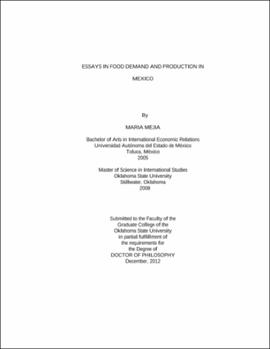| dc.contributor.advisor | Peel, Derrell S. | |
| dc.contributor.author | Mejia, Maria | |
| dc.date.accessioned | 2013-11-26T08:22:03Z | |
| dc.date.available | 2013-11-26T08:22:03Z | |
| dc.date.issued | 2012-12 | |
| dc.identifier.uri | https://hdl.handle.net/11244/6527 | |
| dc.description.abstract | Scope and Method of Study: The first essay analyzes separability among preferences of the major food groups in Mexico. A two-step censored model and separability restrictions were conducted to determine if beans and potatoes are separable from meats and cereals, respectively. The second essay uses the example of Mexico to determine different levels of income effect on consumption patterns of different food categories over time. Using a two-step censored model and cross sectional data for different years, this tudy estimates the relationship between expenditure of certain categories and different income levels by deciles over time. The third essay simulates allocation of resources among the major crops produced in Mexico. A multi-region, comparative static programming model of the crop subsector in Mexico was used to determine the effect of a more market based system. | |
| dc.description.abstract | Findings and Conclusions: The first essay found that preferences of cereals and meats are not separable from potatoes and beans, respectively. Empirical evidence suggest that beans, as a vegetable protein source, should be included with meats for a complete meat demand specification and that potatoes should be included with cereals as a starch source when studying Mexican preferences of cereals and meats. The second essay found that budget allocation on food categories between high income households and low income households is revealing. This study has provided quantitative evidence of the effect of income distribution on consumption patterns over time, and of the need to incorporate various levels of income in model for consumer behavior when wide income disparities are present. The third essay found that a more market based agricultural system has a significant effect on production of the major crops in Mexico. The study used as an example the impact that a cash payment (Procampo) has on the production of the major crops in Mexico. Results suggest that the program has a positive effect on the majority of the major crops except for rice. Mexico has faced significant competition of arable land for food production and the recent growth in demand for feed crops heightens this critical situation. Increased profit potential on feed crops such as yellow corn also depends on the availability of agricultural inputs such as fertilizer and seed. | |
| dc.format | application/pdf | |
| dc.language | en_US | |
| dc.rights | Copyright is held by the author who has granted the Oklahoma State University Library the non-exclusive right to share this material in its institutional repository. Contact Digital Library Services at lib-dls@okstate.edu or 405-744-9161 for the permission policy on the use, reproduction or distribution of this material. | |
| dc.title | Essays in food demand and production in Mexico | |
| dc.contributor.committeeMember | Epplin, Francis | |
| dc.contributor.committeeMember | Vitale, Jeffrey | |
| dc.contributor.committeeMember | Klatt, Arthur | |
| osu.filename | Mejia_okstate_0664D_12482.pdf | |
| osu.accesstype | Open Access | |
| dc.type.genre | Dissertation | |
| dc.type.material | Text | |
| dc.subject.keywords | cereals | |
| dc.subject.keywords | crop production | |
| dc.subject.keywords | demand | |
| dc.subject.keywords | meats | |
| dc.subject.keywords | mexico | |
| dc.subject.keywords | separability | |
| thesis.degree.discipline | Agricultural Economics | |
| thesis.degree.grantor | Oklahoma State University | |
